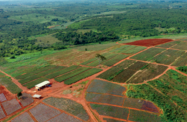Although Ghana’s cocoa production fell short of industry forecasts for the 2015/16 growing season, increased investment in seed development programmes and infrastructure upgrades should improve output over the coming years.
Another slow year
Crop production for the 2015/16 growing season, which spans October to September, reached 690,000 tonnes, although this fell short of the 850,000-tonne projection made by the Ghana Cocoa Board (COCOBOD), the state promotion and oversight agency.
Yields from both the main harvest and the secondary harvest, which began in late June, were impacted by a prolonged and particularly severe harmattan, a dry wind that blows in from the Sahara Desert, as well as by low rainfall at critical times during the growing cycle.
While most of Ghana’s agricultural output is rain-fed, with the drought impacting production across the sector more broadly, cocoa is particularly vulnerable to the harmattan, which dries seeds and erodes yields.
In addition, the proliferation of illegal mining also takes an environmental toll, negatively affecting the cocoa segment, according to Charity Sackitey, managing director for cocoa and chocolate producer Barry Callebaut Ghana.
“Another concern is the proximity of illegal and small-scale mining to cocoa plantations, as heavy metal poisoning and pollution are degrading the land and affecting freshwater and underground aquifers,” she told OBG.
Past performance
The latest result is also well below Ghana’s 2014/15 cocoa output – which totalled 730,000 tonnes, below COCOBOD’s forecast of 1m tonnes, due to an outbreak of black pod disease and adverse weather conditions that year.
The low 2014/15 harvest meant that, for only the third time in the past decade, cocoa had to be imported from Côte d'Ivoire to cover the shortfall. Ghana imported 15,500 tonnes of light crop cocoa beans, Seth Terkper, minister of finance, told parliament earlier this year. The beans were used to supplement local production to fulfill companies’ processing capacity.
However, it is not just Ghana – the world’s second-largest cocoa producer after Côte d'Ivoire – that is experiencing a drop in output.
In August the International Cocoa Organisation (ICCO) revised its global production estimates for the 2015/16 season. Total global output was forecasted to reach 3.99m tonnes, a decline of 5.9% year-on-year, which would leave a 212,000-tonne supply shortfall, the ICCO bulletin said.
Ambitious target
Still, the dip appears to be temporary and future prospects for the industry are more bullish. Earlier this year, COCOBOD announced it was planning to more than double cocoa output to 1.6m tonnes by 2026.
The sector body is committed to distributing up to 60m free hybrid cocoa seedlings per year. The new variety is more resistant to pests and diseases, including black pod disease, and able to withstand harsher weather conditions. As of mid-September, the agency had distributed 110m hybrid cocoa seedlings from its nurseries, according to press reports.
The seedlings are also expected to increase yields, according to Isaac Yaw Opoku, executive director of the Seed Production Unit at COCOBOD.
“Currently, the crops we have in the farms have an average yield level of about 450 to 500 kg per ha,” Opoku told local media at the launch of the initiative. “However, with the new seedlings that we are giving free of charge, the yield level is between 1000 and 1500 kg per ha.”
Infrastructure upgrades
In addition to COCOBOD’s focus on supporting cocoa production, improvements to Ghana’s transport infrastructure are expected to have some benefits for the cocoa industry.
In recent years, better and expanded road networks have allowed crops to be moved more quickly from plantation to processing centres and export hubs, thereby reducing spoilage.
Further upgrades to the country’s ports – such as the $1.5bn project planned at the Port of Tema, slated for completion at the end of 2019 – are also expected to allow faster loading of export commodities, including cocoa.
Oxford Business Group is now on Instagram. Follow us here for news and stunning imagery from the more than 30 markets we cover.

